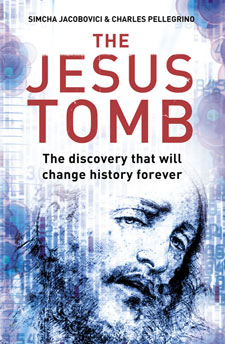Part Indiana Jones, part The Da Vinci Code, and part Discovery Channel with a bit of CSI and Numb3rs thrown in for good measure, the authors of this book claim to have found the final resting place of Jesus and his family's mortal remains.
Hardly backward about coming forward, James Cameron of Titanic fame, claims in the introduction that the book's conclusions are "virtually irrefutable". If that were true the work would certainly live up to its subtitle as "the discovery that will change history forever".
 The book chronicles the four-year investigation by the authors, a journalist and documentary maker, into a tomb from the first century discovered near Jerusalem in 1980. It was inspected by Israeli archeologists and found to contain ossuaries (bone boxes) which were labeled with names such as "Jesus, son of Joseph", "Maria" (the Latinized version of Mary), "Mariamne also known as Mara" and "Judah, son of Jesus". Once a connection is made between "Mariamne" and Mary Magdalene on the basis of the apocryphal Acts of Philip, this becomes an extremely interesting collection of names.
The book chronicles the four-year investigation by the authors, a journalist and documentary maker, into a tomb from the first century discovered near Jerusalem in 1980. It was inspected by Israeli archeologists and found to contain ossuaries (bone boxes) which were labeled with names such as "Jesus, son of Joseph", "Maria" (the Latinized version of Mary), "Mariamne also known as Mara" and "Judah, son of Jesus". Once a connection is made between "Mariamne" and Mary Magdalene on the basis of the apocryphal Acts of Philip, this becomes an extremely interesting collection of names.
Statistics are brought in to investigate the probability of such a collection of names happening by chance (1 in 600 is their conservative figure), DNA decoding to show that Jesus and Mariamne are not related and so must be married to be in the same tomb, with Judah obviously being their child (although no DNA test was done there!).
Never dull, the reader is taken through the mechanics of second burial practices near Jerusalem, wild speculations about the origins of the Knights Templar and descriptions of life and tensions in modern Israel.
There is much to learn about: the origin of the skull and cross bone pirate insignia; recent discoveries of the ossuary box of Simon of Cyrene, who carried Christ's cross; and the family tomb of Caiaphas, High Priest at the time of Jesus.
These last items help to show the inconsistencies in the argument. They are appealed to as examples of recognized finds of figures from the New Testament, so why shouldn't this tomb be similarly recognised?
The problem with this reasoning is that both of these discoveries support the historicity of the Gospel narratives. They got the names right, including small details and minor characters. The authors themselves appeal to a peculiar spelling of Jesus' brother's name " Jos'e, in Mark 6:3 " to identify one of the other ossuaries in the tomb.
If the New Testament documents have proved so reliable would it really have made such a simple mistake as getting Mary of Magdalene's name wrong? Calling her Mariamne would certainly have made some narratives easier to follow. Similarly we are asked to believe that the Gospel writers forgot to tell us that Jesus was married, had a son (of which there is not a shred of evidence) and most importantly, lied about the resurrection.
Furthermore the writers happily appeal to much later and clearly less historically reliable documents such as the Acts of Philip, which also features talking animals(!) to support their case, along with extraordinarily idiosyncratic readings of the gospel narratives (the naked youth = Jesus' son = the beloved disciple = Thomas).
Others have pointed to other unexplained issues, such as why is the Jesus family tomb in Jerusalem rather than Nazareth? How did such a poor family afford such a tomb? Why are there so many languages in the tomb? How reliable is the statistical analysis?
The whole argument finally rests on a big "if" on page 3 " "If the disciples took the body".
If the authors are to present a historical case they would have to present an argument as to how Christianity started if the leader is dead and buried. As has been well said, Christianity could not have got off the ground if Jesus was still in the ground. A crucified Jesus could not be the Messiah. Rather he would be cursed by having died on a cross and all the hopes of the disciples for the restoration of Israel were as dead and buried as he was.
With no resurrection there is simply no Christianity. Certainly the disciples would not have started a faith, for which they were constantly persecuted, if they and others knew it as a lie. It seems that rather than the book changing history, the authors have had to change history for the sake of their book. They have also ignored the implications of the resurrection for who Jesus is.
First there was the documentary, now we have the book and soon, no doubt, there will be the t-shirt. However, the t-shirt is the only one of the three worth buying, as it has the least holes in it.

















